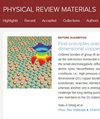单层极限中的萤石型材料
IF 3.4
3区 材料科学
Q2 MATERIALS SCIENCE, MULTIDISCIPLINARY
引用次数: 0
摘要
众所周知,2H、1T 及其扭曲结构是 AB2 单层的原型结构。在此,我们研究了一种从萤石型材料 (110) 表面截断的皱褶(PCK)结构。我们基于第一原理方法研究了 53 种萤石型材料。形成能计算表明,有七个体系在单层极限下形成 PCK 结构,而其他体系则形成 1T、2H 或扭曲的 1T 结构。PbF2 和 Ga2Au 的 PCK 结构在平面外方向呈现负泊松比(NPR)。我们通过假定面内应变下原子间距离恒定的分析模型来解释负泊松比。此外,我们还基于表面能计算和 Born 有效电荷分析,证明了 NPR 的出现与体系的非离子特性相关。我们还发现 PCK 结构中的 PRh2 高度扭曲。本文章由计算机程序翻译,如有差异,请以英文原文为准。

Fluorite-type materials in the monolayer limit
The 2H, 1T, and their distorted structures are known as prototype structures of monolayers. Here, we study a puckered (PCK) structure that is truncated from the (110) surface of fluorite-type materials. 53 fluorite-type materials are investigated based on first-principles approach. The formation energy calculations indicate that seven systems form the PCK structure in the monolayer limit, while other systems form either 1T, 2H, or distorted 1T structures. The PCK structures of and exhibit negative Poisson's ratio (NPR) in the out-of-plane direction. We explain the NPR by an analytical model assuming a constant interatomic distance under the in-plane strain. In addition, we demonstrate that the appearance of NPR is correlated with non-ionic character of the system, which is based on the surface energy calculations and the Born effective charge analyses. We also find that in the PCK structure is highly distorted.
求助全文
通过发布文献求助,成功后即可免费获取论文全文。
去求助
来源期刊

Physical Review Materials
Physics and Astronomy-Physics and Astronomy (miscellaneous)
CiteScore
5.80
自引率
5.90%
发文量
611
期刊介绍:
Physical Review Materials is a new broad-scope international journal for the multidisciplinary community engaged in research on materials. It is intended to fill a gap in the family of existing Physical Review journals that publish materials research. This field has grown rapidly in recent years and is increasingly being carried out in a way that transcends conventional subject boundaries. The journal was created to provide a common publication and reference source to the expanding community of physicists, materials scientists, chemists, engineers, and researchers in related disciplines that carry out high-quality original research in materials. It will share the same commitment to the high quality expected of all APS publications.
 求助内容:
求助内容: 应助结果提醒方式:
应助结果提醒方式:


